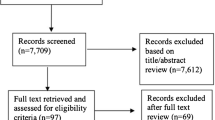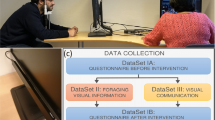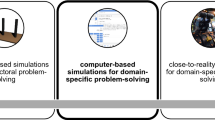Abstract
We propose an experimental protocol to promote empathy towards non-verbal people, based in the training of communication with an eye-tracking device. Our framework includes one eye-tracker, one communication interface and one questionnaire. The questionnaire is applied before and after the intervention, assessing the empathy level of participants in both stages of the experiment and it extends a validated questionnaire (QCAE) to measure empathy. Our results show that, while the empathy levels seem to decrease in both control and test groups, the decrease in the test group is not as significant as in the control group. The statistical power to distinguish between the scores in both groups is 75%. While both QCAE and our extended questionnaire show a strong correlation (\(R^2=0.95\)), our extended questionnaire is more sensitive in distinguishing between both groups than the standard QCAE for which we obtain a power of 63%. Finally, we discuss limitations and future directions, such as extending the study to a larger sample and applying it to different school or working contexts.
Access this chapter
Tax calculation will be finalised at checkout
Purchases are for personal use only
Similar content being viewed by others
Notes
References
Catala, A.: Metaepistemic injustice and intellectual disability: a pluralist account of epistemic agency. Ethical Theory Moral Pract. 23(5), 755–776 (2020)
Farr, E., Altonji, K., Harvey, R.L.: Locked-in syndrome: practical rehabilitation management. PM&R (2021)
Krohn, O.A.N., Varankian, V., Lind, P.G., Moreno e Mello, G.B.: Construction of an inexpensive eye tracker for social inclusion and education. In: Antona, M., Stephanidis, C. (eds.) HCII 2020. LNCS, vol. 12188, pp. 60–78. Springer, Cham (2020). https://doi.org/10.1007/978-3-030-49282-3_5
Lapakko, D.: Communication is 93 nonverbal: an urban legend proliferates. Commun. Theater Assoc. Minnesota J. 34, 7–19 (2007)
Mehrabian, A.: Nonverbal Communication. Routledge (2017)
Poletti, B., et al.: An eye-tracker controlled cognitive battery: overcoming verbal-motor limitations in ALS. J. Neurol. 264(6), 1136–1145 (2017)
Prabaswari, A.D., Utomo, B.W., Purnomo, H.: Eye tracker evaluation on google classroom using use questionnaire. J. Phys. Conf. Ser. 1764, 012181 (2021)
Reniers, R.L., Corcoran, R., Drake, R., Shryane, N.M., Völlm, B.A.: The QCAE: a questionnaire of cognitive and affective empathy. J. Pers. Assess. 93(1), 84–95 (2011)
Robinson, C., Brulé, E., Jackson, J., Torjussen, A., Kybett, J. and Appshaw, T. (2020). Tricks and treats: Designing technology to support mobility assistance dogs. In Proceedings of the 2020 CHI Conference on Human Factors in Computing Systems (pp. 1–14)
Schellenberg, F., Gnad, D.R., Moradi, A., Tahoori, M.B.: An inside job: remote power analysis attacks on FPGAs. IEEE Design & Test (2021)
Smith, E., Delargy, M.: Locked-in syndrome. BMJ 330(7488), 406–409 (2005)
Zhang, X., Kulkarni, H., Morris, M.R.: Smartphone-based gaze gesture communication for people with motor disabilities. In: Proceedings of the 2017 CHI Conference on Human Factors in Computing Systems, pp. 2878–2889 (2017)
Acknowledgements
The authors thank Prof. Dr. Renate Reniers, from the Institute of Clinical Sciences at the University of Birmingham, for providing us the questionnaire which we adapted to our intervention. Moreover, we are grateful to all the students and employees at Oslo Metropolitan University, who volunteered to participate in the experiment. SB thanks the Department of Computer Science and the OsloMet Research Center for AI (ORCA) at OsloMet for financial support.
Author information
Authors and Affiliations
Editor information
Editors and Affiliations
Rights and permissions
Copyright information
© 2021 Springer Nature Switzerland AG
About this paper
Cite this paper
Bhurtel, S., Lind, P.G., Moreno e Mello, G.B. (2021). For a New Protocol to Promote Empathy Towards Users of Communication Technologies. In: Stephanidis, C., Antona, M., Ntoa, S. (eds) HCI International 2021 - Late Breaking Posters. HCII 2021. Communications in Computer and Information Science, vol 1498. Springer, Cham. https://doi.org/10.1007/978-3-030-90176-9_1
Download citation
DOI: https://doi.org/10.1007/978-3-030-90176-9_1
Published:
Publisher Name: Springer, Cham
Print ISBN: 978-3-030-90175-2
Online ISBN: 978-3-030-90176-9
eBook Packages: Computer ScienceComputer Science (R0)




